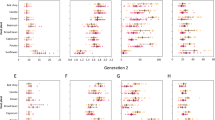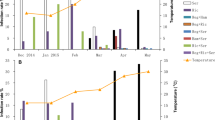Abstract
The whitefly Bemisia tabaci complex contains many cryptic species, of which the Middle East-Asia Minor 1 (MEAM1) and Mediterranean (MED) are notorious invasive pests. In our field-collected whitefly samples, MEAM1 harbors an obligate primary symbiont “Candidatus Portiera aleyrodidarum” and two secondary symbionts, “Candidatus Hamiltonella defensa” and Rickettsia sp., whereas MED has only “Ca. Portiera aleyrodidarum” and “Ca. Hamiltonella defensa.” Both “Ca. Portiera aleyrodidarum” and “Ca. Hamiltonella defensa” are intracellular endosymbionts residing in the bacteriomes, whereas Rickettsia sp. has a scattered distribution throughout the host body cavity. We examined responses of these symbionts to adverse temperatures as well as survival of the host insects. After cold treatment at 5 or 10 °C or heat treatment at 35 or 40 °C for 24 h, respectively, the infection rates of all symbionts were not significantly decreased based on diagnosis PCR. However, quantitative PCR assays indicated significant reduction of “Ca. Hamiltonella defensa” at 40 °C, and the reduction became greater as the duration increased. Compared with “Ca. Hamiltonella defensa,” “Ca. Portiera aleyrodidarum” was initially less affected in the first day but then showed more rapid reduction at days 3–5. The density of Rickettsia sp. fluctuated but was not reduced significantly at 40 °C. Meanwhile, the mortality rates of the host whiteflies elevated rapidly as the duration of exposure to heat treatment increased. The differential responses of various symbionts to adverse temperatures imply complex interactions among the symbionts inside the same host insect and highlight the importance of taking the whole bacterial community into account in studies of symbioses.






Similar content being viewed by others
References
Baumann P (2005) Biology of bacteriocyte-associated endosymbionts of plant sap-sucking insects. Annu Rev Microbiol 59:155–189
Douglas AE (1998) Nutritional interactions in insect-microbial symbioses: aphids and their symbiotic bacteria Buchnera. Annual Rev Entomol 43:17–37
Feldhaar H (2011) Bacterial symbionts as mediators of ecologically important traits of insect hosts. Ecol Entomol 36:533–543
Oliver KM, Degnan PH, Burke GR, Moran NA (2010) Facultative symbionts in aphids and the horizontal transfer of ecologically important traits. Annual Rev Entomol 55:247–266
Sandström JP, Russell JA, White JP, Moran NA (2001) Independent origins and horizontal transfer of bacterial symbionts of aphids. Mol Ecol 10:217–228
Bensadia F, Boudreault S, Guay JF, Michaud D, Cloutier C (2006) Aphid clonal resistance to a parasitoid fails under heat stress. J Insect Physiol 52:146–157
Burke G, Fiehn O, Moran N (2010) Effects of facultative symbionts and heat stress on the metabolome of pea aphids. The ISME J 4:242–252
Dunbar HE, Wilson ACC, Ferguson NR, Moran NA (2007) Aphid thermal tolerance is governed by a point mutation in bacterial symbionts. PLoS Biol 5:e96
Montllor CB, Maxmen A, Purcell AH (2002) Facultative bacterial endosymbionts benefit pea aphids Acyrthosiphon pisum under heat stress. Ecol Entomol 27:189–195
Brumin M, Kontsedalov S, Ghanim M (2011) Rickettsia influences thermotolerance in the whitefly Bemisia tabaci B biotype. Insect Sci 18:57–66
Wernegreen JJ (2012) Mutualism meltdown in insects: bacteria constrain thermal adaptation. Curr Opin Microbiol 15:255–262
Russell JA, Moran NA (2006) Costs and benefits of symbiont infection in aphids: variation among symbionts and across temperatures. Proc Biol Sci 273:603–610
Guay JF, Boudreault S, Michaud D, Cloutier C (2009) Impact of environmental stresstreatment on aphid clonal resistance to parasitoids: role of Hamiltonella defensa bacterial symbiosis in association with a new facultative symbiont of the pea aphid. J Insect Physiol 55:919–926
Gottlieb Y, Ghanim M, Gueguen G, Kontsedalov S, Vavre F, Fleury F, Zchori-Fein E (2008) Inherited intracellular ecosystem: symbiotic bacteria share bacteriocytes in whiteflies. FASEB J 22:2591–2599
Thao ML, Baumann P (2004) Evolutionary relationships of primary prokaryotic endosymbionts of whiteflies and their hosts. Appl Environ Microbiol 70:3401–3406
Bing XL, Yang J, Zchori-Fein E, Wang XW, Liu SS (2013) Characterization of a newly discovered symbiont of the whitefly Bemisia tabaci (Hemiptera: Aleyrodidae). Appl Environ Microbiol 79:569–575
Everett KDE, Thao M, Horn M, Dyszynski GE, Baumann P (2005) Novel chlamydiae in whiteflies and scale insects: endosymbionts ‘Candidatus Fritschea bemisiae’ strain Falk and ‘Candidatus Fritschea eriococci’ strain Elm. Int J Syst Evol Microbiol 55:1581–1587
De Barro PJ, Liu SS, Boykin LM, Dinsdale AB (2011) Bemisia tabaci: a statement of species status. Annual Rev Entomol 56:1–19
Dinsdale A, Cook L, Riginos C, Buckley YM, De Barro P (2010) Refined global analysis of Bemisia tabaci (Hemiptera: Sternorrhyncha: Aleyrodoidea: Aleyrodidae) mitochondrial cytochrome oxidase 1 to identify species level genetic boundaries. Ann Entomol Soc Am 103:196–208
Firdaus S, Vosman B, Hidayati N, Jaya Supena ED, Visser RG, van Heusden AW (2013) The Bemisia tabaci species complex: additions from different parts of the world. Insect Sci 20:723–733
Liu SS, Colvin J, De Barro PJ (2012) Species concepts as applied to the whitefly Bemisia tabaci systematics: how many species are there? J Integr Agric 11:176–186
Bing XL, Ruan YM, Rao Q, Wang XW, Liu SS (2013) Diversity of secondary endosymbionts among different putative species of the whitefly Bemisia tabaci. Insect Sci 20:194–206
Sun DB, Liu YQ, Qin L, Xu J, Li FF, Liu SS (2013) Competitive displacement between two invasive whiteflies: insecticide application and host plant effects. B Entomol Res 103:344–353
Luan JB, Ruan YM, Zhang L, Liu SS (2008) Pre-copulation intervals, copulation frequencies, and initial progeny sex ratios in two biotypes of whitefly, Bemisia tabaci. Entomol Exp Appl 129:316–324
De Barro PJ, Driver F (1997) Use of RAPD PCR to distinguish the B biotype from other biotypes of Bemisia tabaci (Gennadius) (Hemiptera: Aleyrodidae). Aus J Entomol 36:149–152
Zang LS, Liu YQ, Liu SS (2005) A new clip-cage for whitefly experimental studies. Entomol Knowl 42:329–331 (in Chinese with English summary)
Mahadav A, Kontsedalov S, Czosnek H, Ghanim M (2009) Thermotolerance and gene expression following heat stress in the whitefly Bemisia tabaci B and Q biotypes. Insect Biochem Mol Biol 39:668–676
Nava-Camberos U, Riley DG, Harris MK (2001) Temperature and host plant effects on development, survival, and fecundity of Bemisia argentifolii (Homoptera: Aleyrodidae). Environ Entomol 30:55–63
Frohlich DR, Torres-Jerez I, Bedford ID, Markham PG, Brown JK (1999) A phylogeographical analysis of the Bemisia tabaci species complex based on mitochondrial DNA markers. Mol Ecol 8:1683–1691
Gottlieb Y, Ghanim M, Chiel E, Gerling D, Portnoy V, Steinberg S, Tzuri G, Horowitz AR, Belausov E, Mozes-Daube N, Kontsedalov S, Gershon M, Gal S, Katzir N, Zchori-Fein E (2006) Identification and localization of a Rickettsia sp. in Bemisia tabaci (Homoptera: Aleyrodidae). Appl Environ Microbiol 72:3646–3652
Caspi-Fluger A, Inbar M, Mozes-Daube N, Mouton L, Hunter MS, Zchori-Fein E (2011) Rickettsia ‘in’and ‘out’: two different localization patterns of a bacterial symbiont in the same insect species. PLoS One 6:e21096
Anbutsu H, Goto S, Fukatsu T (2008) High and low temperatures differently affect infection density and vertical transmission of male-killing Spiroplasma symbionts in Drosophila hosts. Appl Environ Microbiol 74:6053–6059
Fan Y, Wernegreen JJ (2013) Can't take the heat: high temperature depletes bacterial endosymbionts of ants. Microb Ecol 66:727–733
Prado SS, Hung KY, Daugherty MP, Almeida RPP (2010) Indirect effects of temperature on stink bug fitness, via maintenance of gut-associated symbionts. Appl Environ Microbiol 76:1261–1266
Elbaz M, Weiser M, Morin S (2011) Asymmetry in thermal tolerance trade-offs between the B and Q sibling species of Bemisia tabaci (Hemiptera: Aleyrodidae). J Evol Biol 24:1099–1109
Salvucci ME (2000) Sorbitol accumulation in whiteflies: evidence for a role in protecting proteins during heat stress. J Therm Biol 25:353–361
Salvucci ME, Stecher DS, Henneberry TJ (2000) Heat shock proteins in whiteflies, an insect that accumulates sorbitol in response to heat stress. J Therm Biol 25:363–371
Brownlie JC, Johnson KN (2009) Symbiont-mediated protection in insect hosts. Trends Microbiol 17:348–354
Zindel R, Gottlieb Y, Aebi A (2011) Arthropod symbioses: a neglected parameter in pest- and disease-control programmes. J Appl Ecol 48:864–872
Frago E, Dicke M, Godfray HCJ (2012) Insect symbionts as hidden players in insect–plant interactions. Trends Ecol Evol 27:705–711
Thierry M, Becker N, Hajri A, Reynaud B, Lett JM, Delatte H (2011) Symbiont diversity and non-random hybridization among indigenous (Ms) and invasive (B) biotypes of Bemisia tabaci. Mol Ecol 20:2172–2187
Zchori-Fein E, Brown JK (2002) Diversity of prokaryotes associated with Bemisia tabaci (Gennadius) (Hemiptera: Aleyrodidae). Ann Entomol Soc Am 95:711–718
Sinisterra XH, McKenzie CL, Hunter WB, Powell CA, Shatters RG (2005) Differential transcriptional activity of plant-pathogenic begomoviruses in their whitefly vector (Bemisia tabaci, Gennadius: Hemiptera Aleyrodidae). J Gen Virol 86:1525–1532
Acknowledgments
The authors thank Jie Li and Yun-Qin Li for technical advice and assistance. The authors are also grateful to the five anonymous reviewers for their constructive comments that have helped to improve the paper. This study was financially supported by the National Natural Science Foundation of China (Projects no. 31390421 and 31321063).
Author information
Authors and Affiliations
Corresponding author
Rights and permissions
About this article
Cite this article
Shan, HW., Lu, YH., Bing, XL. et al. Differential Responses of the Whitefly Bemisia tabaci Symbionts to Unfavorable Low and High Temperatures. Microb Ecol 68, 472–482 (2014). https://doi.org/10.1007/s00248-014-0424-3
Received:
Accepted:
Published:
Issue Date:
DOI: https://doi.org/10.1007/s00248-014-0424-3




